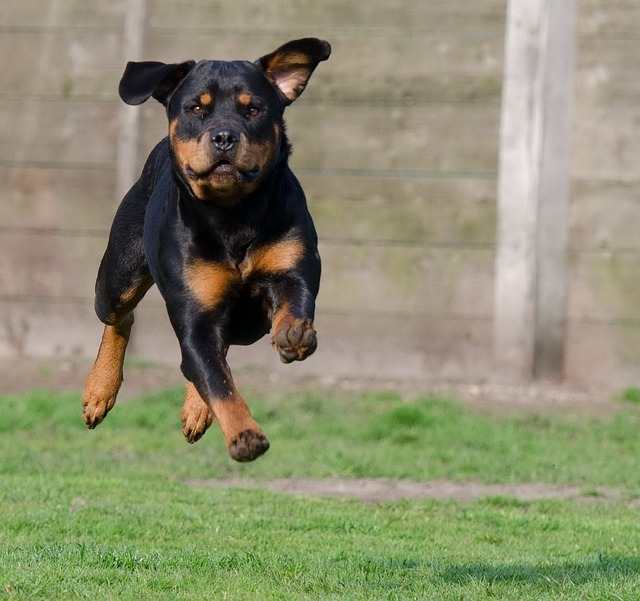


The Rottweiler is a powerful, large, and muscular dog breed known for its loyalty, courage, and protective instincts. Originally bred as a herding and guarding dog, the Rottweiler is often used in roles such as police, military, search and rescue, and service dogs due to its intelligence and strength. While they may appear intimidating, Rottweilers are known for their devotion to their families and can be affectionate and gentle when properly trained and socialized. They require an experienced owner who can provide firm, consistent leadership and meet their physical and mental needs.
The history of the Rottweiler dates back to ancient Roman times, where dogs resembling Rottweilers were used to drive cattle and protect the Roman legions. These dogs were essential to the Roman army as they provided both herding assistance and protection. In the town of Rottweil in Germany, the breed became known as "Rottweil butchers' dogs" because they were used by butchers to guard their livestock and haul carts of meat to market. Over time, the breed was refined and became a strong, reliable working dog. In the 19th century, Rottweilers transitioned into a role as police and guard dogs, a reputation that continues today. Despite a decline in popularity in the early 20th century, Rottweilers became more widely recognized and appreciated during the 1980s, especially in the United States, where they are now one of the most popular breeds.
The Rottweiler is a large, robust dog with a broad, powerful build. Adult Rottweilers typically stand between 22 to 27 inches (56 to 69 cm) tall at the shoulder and weigh between 80 to 135 pounds (36 to 61 kg). They have a short, dense coat that is black with distinct tan markings on their cheeks, legs, and eyebrows. The breed's muscular structure gives it strength and agility, which makes it well-suited for work that requires both power and endurance. Rottweilers have a broad, rounded head, strong jaws, and expressive eyes that convey intelligence and alertness. Their ears are medium-sized and hang down, and their tail is typically docked in some countries, although in others, it may remain natural.
Rottweilers are known for their loyalty, confidence, and protective nature. While they can be reserved and cautious around strangers, they are deeply devoted to their families and make excellent guard dogs and family pets. Rottweilers are intelligent and responsive, which makes them highly trainable, but they can also be independent and sometimes dominant. Early socialization and consistent training are crucial to ensure they develop into well-behaved and balanced dogs. When well-socialized and trained, Rottweilers are affectionate, playful, and gentle with their family members, including children, though their large size may require supervision around younger kids. Their protective instincts make them excellent watchdogs, and they are known to be fearless in the face of threats.
Rottweilers are an active and energetic breed that requires daily exercise to maintain their physical and mental health. They enjoy long walks, jogs, hikes, and play sessions in a secure area. Due to their high intelligence and work ethic, Rottweilers excel in dog sports like obedience, agility, and protection training. Mental stimulation is just as important as physical exercise, as a bored Rottweiler can become destructive. Engaging in activities like fetch, hide-and-seek, or learning new tricks can help fulfill their intellectual needs. Rottweilers are known for their stamina, so they do best in homes with owners who can provide regular and varied forms of exercise. Without sufficient physical and mental activity, they may exhibit unwanted behaviors like chewing or digging.
Rottweilers are intelligent and eager to please, which makes them relatively easy to train. However, due to their independent nature, they require a strong, confident handler who can provide clear leadership. Positive reinforcement methods, such as rewards, praise, and treats, work best when training a Rottweiler. Early socialization is essential to expose them to various people, animals, environments, and situations, ensuring that they develop a well-rounded and calm temperament. Socializing a Rottweiler from a young age helps prevent aggressive tendencies and encourages good behavior. Rottweilers are often very protective of their families, so proper training and socialization are critical to help them differentiate between genuine threats and non-threatening situations.
Rottweilers are generally a healthy breed, but like all dogs, they are prone to certain health issues. Some common health concerns include hip and elbow dysplasia, heart conditions such as dilated cardiomyopathy, and certain types of cancers. Regular veterinary check-ups are essential to monitor for these conditions. Rottweilers should maintain a healthy weight, as they are prone to obesity, which can exacerbate joint problems. Grooming requirements are relatively low due to their short coat, but they should still be brushed regularly to remove loose hair and maintain skin health. Rottweilers should also have their ears checked and cleaned regularly to avoid infections. Additionally, dental care and nail trimming should be part of their routine care.
The average lifespan of a Rottweiler is between 8 to 10 years. With proper care, including regular exercise, a balanced diet, and routine veterinary care, Rottweilers can live longer, more fulfilling lives. It's important to monitor their health closely, particularly regarding joint health and heart conditions, as these can affect their quality of life in their later years. Rottweilers that are kept at a healthy weight and receive proper mental stimulation tend to live longer and are more likely to remain active and happy throughout their lives.
© copyright Dog Compendium 2024 - 2025